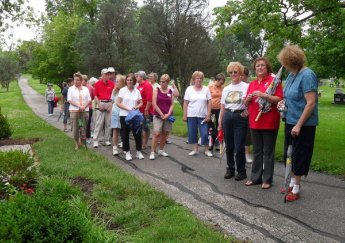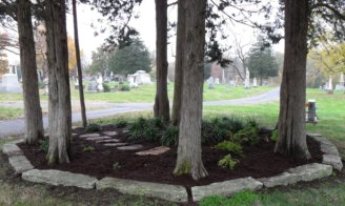|
|
October 2010 Cemetery opens new garden
More and more families are turning to cremation as a cost-effective alternative to a traditional burial. Cremation is the process of reducing human remains to ashes, which are placed in a small container, or urn. After enough time has passed to emotionally release the loved one to a final resting place, some question what to do with the cremated remains. While some families choose to inter the remains in the ground or in a columbarium, others say they want their ashes scattered at the “old home place” or some other meaningful location. One potential drawback to this approach is that those who are left behind might not have a place to go to remember and celebrate that lost life. Columbia Cemetery has added a scattering garden as an option to fulfill this need. The garden is planted with perennials and sits inside an octagonal area that once was home to an old bandstand, or pagoda, used for concerts and public gatherings in the late 1800s. The pagoda eventually was converted into a shed that later burned down from an unattended woodstove fire. A past caretaker planted the cedars framing the garden more than 60 years ago, and the trees have been a landmark in the cemetery ever since. The pagoda’s original limestone foundation stones remain and will become a permanent memorial engraved with the names of those whose ashes are scattered there. By choosing to have cremated remains scattered in Columbia Cemetery, families will always have a place to come and remember those who have passed. Back to top^club activity ... Members of the Columbia Garden Club pause for a closer look at the foliage during a June tour of Columbia Cemetery. Members of the Columbia Garden Club pause for a closer look at the foliage during a June tour of Columbia Cemetery.On June 14, 2010, 38 members of the Columbia Garden Club enjoyed a walking tour of the Columbia Cemetery. Rain from earlier in the day stopped as the tour began, and the overcast skies kept the heat away for the hour-long walk. The cemetery was part of a larger tour consisting of five members’ gardens and included three judges from the Federated Garden Clubs of Missouri. The judges were very complimentary and delighted to have the cemetery on the tour this year. In keeping with the theme of this year’s garden tour, “Let Beauty Surround You,” the overabundance of spring rains made the cemetery grounds quite lush with new growth among its trees, shrubs, flowers and grass. Columbia Cemetery is a fine example of a garden cemetery, a style of burial ground created to commemorate the dead in a tranquil and beautiful natural landscape of trees, shrubs and flowers with carriage roads and walking paths. Garden, or rural, cemeteries were intended for public use from the very beginning. Before the development of public parks, these cemeteries provided a place to enjoy refined outdoor recreation amid the art and sculpture of Victorian-era grave markers. It is not clear if the Columbia Cemetery grounds were originally laid out with the help of a professional landscape architect, but the presence of roadways and walkways indicates some vision early in the cemetery’s history. A set of rules printed in the local newspaper in the 1870s show continued attention to maintaining the grounds: Horses were not to be left untied or allowed to leave the lanes, trees were not to be removed without permission, and the picking of flowers was strictly forbidden. During the tour, garden club members got a glimpse of other places of interest, such as a newly renovated receiving vault built in 1887; the Jewish cemetery established in 1880; the Farley Mausoleum, built in 1911; and the cemetery’s new columbarium and landscaping, which includes a bronze sculpture by famed local artist Sabra Tull Meyer. Garden club members agreed that an hour-long walking tour was not enough time to see all the beautiful cemetery landscape and the unusual and beautiful Victorian funerary art on the massive headstones. They also agreed that a return visit to see the fall foliage and the spring flowers would be needed to take in the whole “garden”. Back to top^Lynching Victim's gravesite garners attentionIn 1923, an angry mob pulled James T. Scott out of the Boone County Jail and hanged him at the Stewart Road Bridge near the University of Missouri campus. Scott, a black MU employee, had been accused of assaulting a 14-year-old white girl and was scheduled for trial the following month. As members of the mob ushered him toward the bridge early in the morning on April 29, Scott proclaimed his innocence but did not resist. “I know I am going to die, but I am innocent,” Scott told his executioners before he was thrown from the bridge, according to a news account at the time. Today, Scott’s grave at Columbia Cemetery is marked with a small metal nameplate. To Clyde Ruffin, pastor at Second Baptist Church, that’s not good enough. Ruffin is behind an effort to raise money for a more appropriate marker. He has in mind a granite monument engraved with the names of Scott and his family, who were members of Second Baptist, along with a statement detailing the events of his death and a message of peace, brotherhood and equal justice under the law. For Ruffin, it’s a way to bring dignity to Scott’s death by lifting the “umbrella of shame” that surrounds it and turn Scott’s gravesite into a symbol of love and equality. “In a lot of ways I believe the story of James T. Scott is not complete without a proper marker,” Ruffin said during a recent organizational meeting at Second Baptist, 407 E. Broadway. An account has been set up at Boone County National Bank to accept donations, and Ruffin has formed a committee to organize a fundraising kickoff in November. The goal is to dedicate a memorial to Scott in April, the month of his death. Back to top^ |
In this issuePhoto gallery
Contact Us
Support us
|

 Columbia Cemetery has converted the site of a former bandstand into a "scattering garden" where families can memorialize loved ones.
Columbia Cemetery has converted the site of a former bandstand into a "scattering garden" where families can memorialize loved ones.